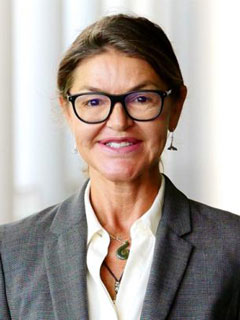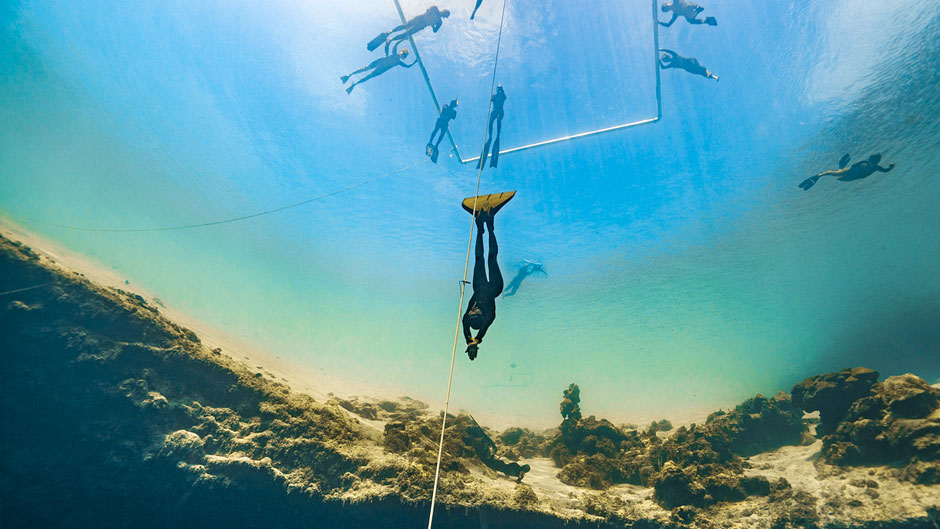Water has always been Claire Paris-Limouzy’s sanctuary.
While growing up in Bordeaux, France, Paris-Limouzy recalls often holding her breath underwater for as long as she could because it brought her a sense of peace. And she relished the time she spent snorkeling off the coast of Sénégal, where her father worked during the summer as a chemical engineer.

“For me, the water is so natural,” said the professor of ocean sciences. “Growing up near the Atlantic in France and West Africa, I was always drawn to the ocean and I wanted to do something in my life to learn more about it.”
Today, the world’s waters are a driving force in Paris-Limouzy’s career and personal life. She is a prolific professor at the University of Miami Rosenstiel School of Marine and Atmospheric Science, where she has designed numerical models and collection devices that help track the movement of currents, fish larvae, plankton, and pollutants through the oceans across the globe.
She is also a member of the United States freediving team, and has set national and Pan-American records for her ability to hold her breath for more than six minutes and swim underwater in a pool for more than 600 feet on one breath. In the ocean, Paris-Limouzy has submerged to a depth of 70 meters (230 feet). These performances have placed her among the top 20 free divers in the world.
“I like to compete,” said Paris-Limouzy, a mother of two, who has also started the first Scientific Freediving program at the University. “Each challenge gives me the self-confidence to push boundaries for myself.”
While Paris-Limouzy had a strong connection with the ocean from an early age, and spent summers surfing and wind surfing, she took her first freediving course just 10 years ago. She began applying her freediving skills to her research in Belize in 2013 while conducting field work for a National Science Foundation project. Each day, Paris-Limouzy and another certified colleague would free dive down 15 to 20 feet to place fish larvae in a drifting chamber she had designed to study the swimming behavior of young fish.
“I realized that freediving was a good technique to use, especially in isolated places where you don’t have scuba tanks or compressors to fill oxygen tanks,” she said, noting that is often the case in remote research locations.
Entering the fray
Six months after the Belize trip, she entered her first freediving competition, Deja Blue in Curaçao. It was there that Paris-Limouzy recognized some of the physiological changes that occur in humans while freediving. In particular, once we hold our breath and submerge, the mammalian reflex kicks in and the heartbeat slows down. There is a shunting of blood flow from the extremities to the essential organs, and the human spleen contracts, producing more blood cells. So, we don’t have as strong of an urge to breathe, Paris-Limouzy said. After a certain depth, our lungs compress to the point where we become negatively buoyant and, in what is called “the sink phase,” then our body descends easier, and we do not have to kick because we are free falling.
“As you descend farther underwater, your partial pressure of oxygen increases, so it feels like you have more air, and since your heartbeat has slowed, you are also using less oxygen, too,” she said.
After placing fourth in her first competition, Paris-Limouzy recognized her ability to excel in the sport. She began training with the help of her husband, freediving instructor Ricardo Paris, as well as Antonio Del Duca, a professional Venezuelan free diver. Less than two years later, she set a U.S. record for swimming 128 meters, or 420 feet on a single breath, without fins. Since then, Paris-Limouzy has set other U.S. records—for swimming 184 meters (about 604 feet) with a monofin in 2018, and swimming 187 meters (about 613 feet) underwater with a monofin on a single breath in 2019.
Today, her husband continues to serve as one of her coaches, while Paris-Limouzy also video chats with Croatian free diver Mirela Karasevic to plan training sessions. She swims in a pool two to three times a week and once a week in the ocean. In addition, she awakens around 4 a.m. every day and does breathing exercises and yoga to build flexibility and breath-hold capacity. Paris-Limouzy also added Budokon yoga—which includes martial arts, calisthenics, and animal locomotion—into her routine in 2019 to improve her endurance.
“The deeper you go, the more you learn about yourself,” she said. “I don’t have any specific record I want to break, but I do want to continue to go deeper into this practice.”
Beyond her interest in competing, Paris-Limouzy said that freediving has been beneficial to her research. When she was working to create a numerical model of how oil from the 2010 Deepwater Horizon spill dispersed in the Gulf of Mexico, Paris-Limouzy said her experience freediving—along with her master’s degree in biochemistry—helped her realize how the pressure changes underwater forced the gas content of the oil to atomize into tiny droplets that would stay submerged. This meant the spill was actually much larger than the slick that could be photographed from satellites above the ocean. “I understood how to model these processes that have to do with pressure and gas because I experienced it myself while freediving,” she said.
Freediving also allows her to observe marine life in a nonintrusive way. Without the noise of scuba tanks, she can see fish and marine mammals exhibit natural behaviors, which is another area she studies. While on a fellowship in Sydney, Australia, she and her husband went freediving in the Great Barrier Reef, where they watched sharks hunting and a potato grouper swam right in front of their faces. Paris-Limouzy also used her freediving skills to swim alongside humpback whales in Moorea, French Polynesia, one summer. “In freediving, you can quietly descend when you see something interesting,” she said. “The fish come up to you.”
Sharing her skills
Now, Paris-Limouzy wants to share the benefits of freediving for science with her students. Last spring, she and her husband Ricardo, who is also president of the Board of Directors for U.S.A. Freediving, taught the first class of Scientific Freediving at Rosenstiel. In it, eight female students earned a freediving certification from the Professional Association of Diving Instructors (PADI). The couple is now hoping to offer the first Scientific Freediving certification program in the country at the University of Miami, where students, faculty, and staff could get certified in freediving for underwater research.
“This doesn’t exist at any university in the world,” Paris-Limouzy said. “We are providing a platform to do science safely and more efficiently using these techniques.”
Frederick Hanselmann, director of Rosenstiel’s Underwater Archaeology and Underwater Exploration program, as well as the chair of its diving control board, said he sometimes uses freediving for his research and believes it would be immensely useful if more Rosenstiel students and faculty members were trained in the practice.
“Having the ability to dive on a breath hold safely is very important,” he said. “And when you have someone that is at the top of the field in that activity teaching the class, you know your students are getting the best training possible.”

